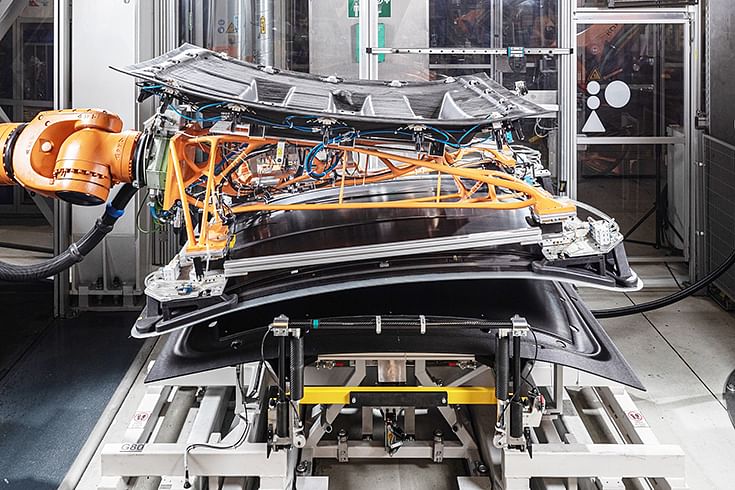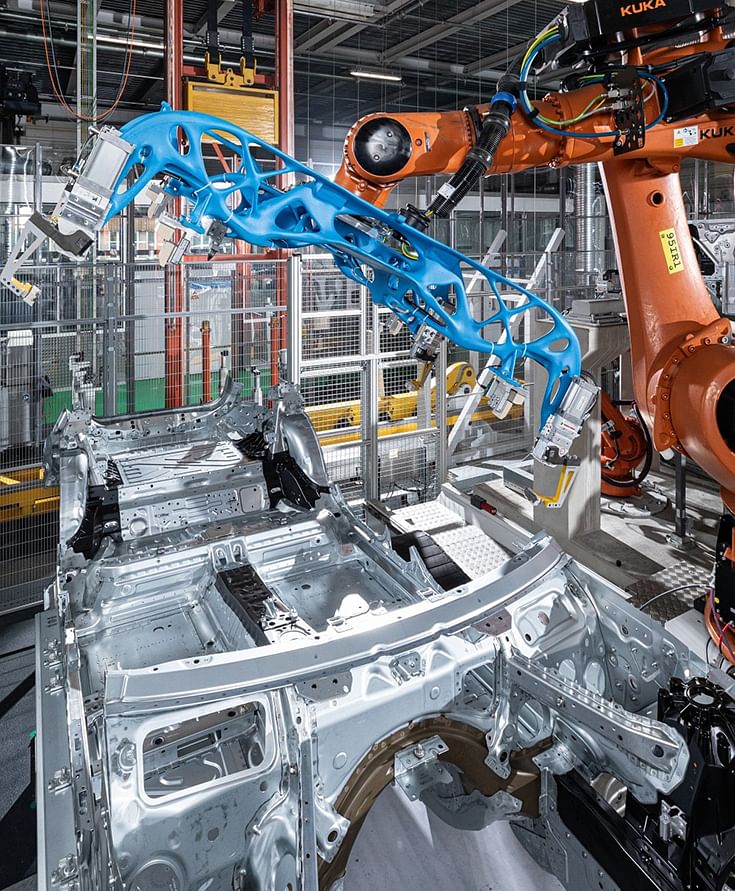BMW Group expands use of 3D-printed, customised robot grippers
Innovative bionic gripper deployed for entire floor assemblies at BMW Group Plant Munich; more than 400,000 parts produced worldwide using 3D printing
With more than 30 years of experience, the BMW Group is a pioneer in the field of additive manufacturing, better known as 3D printing. 3D printers have been used from as early as 1991 to produce individual vehicle parts and components, initially for concept cars, prototypes and race cars, then later for production models. The BMW Group now also manufactures many work aids and tools for its own production system in various 3D printing processes. From tailor-made orthoses for employees, and teaching and production aids, to large, weight-optimised robot grippers, used for such things as CFRP roofs and entire floor assemblies.
At the ‘Additive Manufacturing Campus’ in Oberschleibheim, the BMW Group’s central hub for production, research and training in 3D printing, more than 300,000 parts were ‘printed’ in 2023. Furthermore, over 100,000 printed parts were produced per year across all the plants that form the global production network, from Spartanburg and the German plants to sites in Asia.
“The increasing use of additive manufacturing in the BMW Group production system has many benefits. For example, we are able to quickly, economically, and flexibly produce our own production aids and handling robots, which we can individually adapt to specific requirements at any time, as well as being able to optimise their weight. Less weight allows higher speeds on the production line, shorter cycle times and reduced costs. Plus, smaller robots can be used in the medium term, which also cuts CO2 emissions and costs,” says Jens Ertel, Head of BMW Additive Manufacturing.
Additive manufacturing processes have been used on a daily basis for a long time at BMW Group Plant Landshut. For many years, these have included moulds for the manufacturing of aluminium cylinder heads, which are printed three-dimensionally using the sand casting process. Here, sand is repeatedly applied in thin layers and stuck together using binders. This makes it possible to create moulds for the manufacturing of very complex structures, which are then filled with liquefied aluminium.

Using 3D printing to manufacture large robot grippers for CFRP roofs
For a number of years, the BMW Group’s Lightweight Construction and Technology Centre in Landshut has been using a particularly large gripper element, which was made using the 3D printing process. Weighing around 120 kilograms, the gripper for a robot can be manufactured in just 22 hours and is then used on a press in the production of all CFRP roofs for BMW M GmbH models.
The press is first loaded with the CFRP raw material. The gripper is simply rotated 180 degrees to remove the finished roofs. Compared to conventional grippers, the version manufactured using 3D printing was roughly 20 percent lighter, which in turn extend the operating life of the robots and also reduced wear and tear on the system, as well as cutting maintenance intervals. The combined use for two steps also reduced the cycle time.
A unique feature of the robot gripper is the ideal combination of two different 3D printing processes. While the vacuum grippers and the clamps for the needle gripper to lift the CFRP raw material are made using selective laser sintering (SLS), the large roof shell and bearing structure are manufactured using large scale printing (LSP). LSP can be used to produce large components economically and sustainably. The process uses injection moulding granules and recycled plastics, while CFRP residual material can also be used and recycled. Compared to the use of primary raw materials, CO2 emissions when manufacturing the gripper are roughly 60 percent lower.
New-gen bionic grippers
In 2023, a new, even lighter generation of gripper was introduced. To achieve this, the previous gripper concept was analysed and optimised topologically – the birth of the bionic robot gripper. This combines the roof shell from the LSP printer with SLS vacuums and a bionically optimised bearing structure. For this, a mould with printed cores is used in the sand casting. This mould is then cast with the intricate aluminium structure.
The new gripper is a further 25 percent lighter than its predecessor, meaning the entire process of manufacturing a CFRP roof of the BMW M3 can be performed with just one robot, rather than three as was previously the case. Nowadays, double grippers manufactured individually within the BMW Group, courtesy of 3D printing, are used for all CFRP roofs at BMW Group Plant Landshut.

New 3D-printed gripper also used in chassis construction in operation
The BMW Group also employs grippers produced using the 3D printing process in chassis construction – for example, grippers printed with the LSP process for dealing with doors at BMW Group Plant Regensburg.
“With an optimised bearing structure produced using 3D printing, we were able to increase the rigidity of the gripper when handling door elements at the plant in Regensburg, while at the same time reducing weight. In subsequent projects, it is then possible to use robots with a low bearing capacity, which helps to cut costs,” says Florian Riebel, Head of Door and Flap Production in Regensburg.
However, the company is now taking it one step further at BMW Group Plant Munich. As of recently, the first examples of a bionic robot gripper have been used at the parent plant. This gripper can hold and move the entire floor assembly of a BMW i4. For the floor assembly gripper, 3D printing is used to create a sand casting mould, which is filled with liquid aluminium. The bearer is optimised in terms of weight and maximum load capacity, and weighs with all additional add-on elements a mere 110 kilograms. That makes it roughly 30 percent lighter than the previous, conventional model.
Manufacturing using sand casting and aluminium makes it possible to represent intricate load-optimised structures. This results in maximum weight reduction and thus makes it possible in the medium term to use smaller and lighter heavy-duty lifting robots, which require less energy and thus reduce CO2 emissions.
RELATED ARTICLES
Skoda begins sale of made-in-India CKD Kushaq in Vietnam
Before production started, pre-series Kushaq vehicles covered over 330,000 kilometres on a variety of Vietnamese roads a...
Six Japanese companies join forces to expand use of recycled materials in new vehicles
Denso, Toray Industries, Nomura Research Institute, Honda Motor, Matec Inc and Rever Corporation have set up the BlueReb...
BYD selects Voestalpine as steel supplier for its Hungarian plant
The announcement of the Austrian steelmaker as a supplier demonstrates BYD’s strategic plan to source from high-quality,...





 By Autocar Professional Bureau
By Autocar Professional Bureau
 27 May 2024
27 May 2024
 3518 Views
3518 Views




























